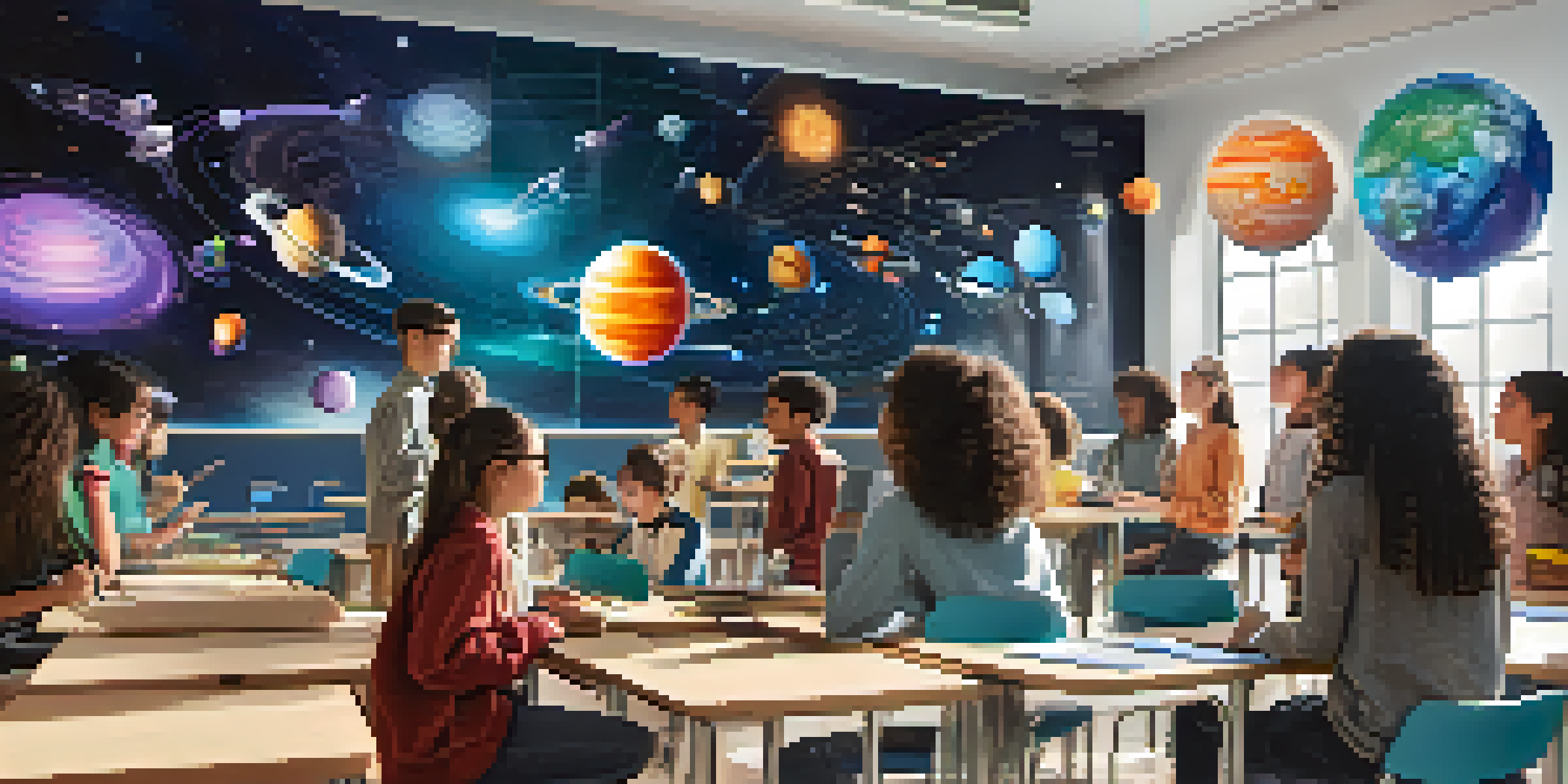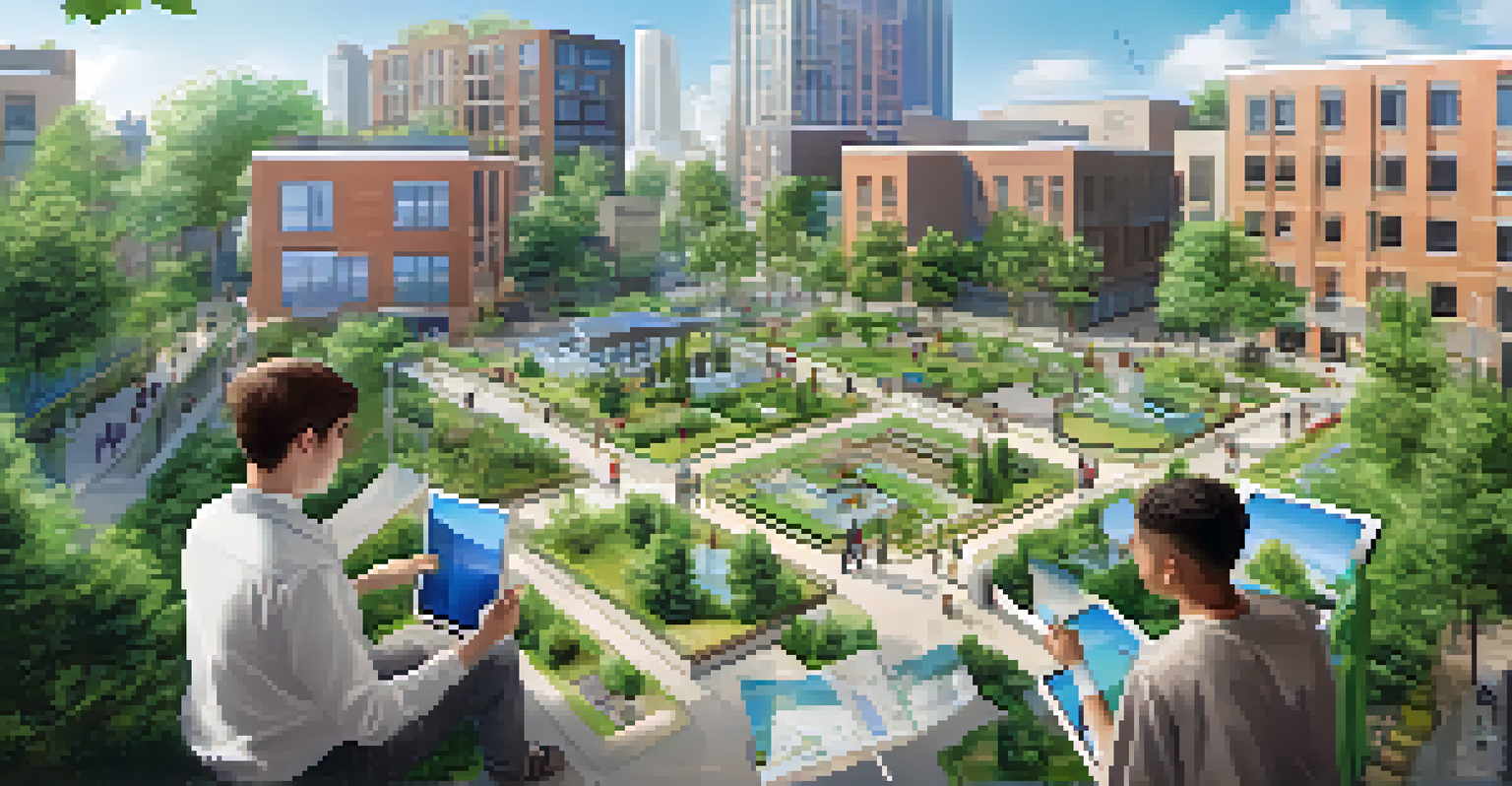Using Augmented Reality for Collaborative Educational Projects

Understanding Augmented Reality in Education
Augmented reality (AR) blends digital information with the real world, creating immersive experiences. In education, AR can transform traditional learning environments into interactive spaces where students can visualize complex concepts. For instance, imagine studying the solar system and being able to see planets orbiting around you in your classroom.
Education is the most powerful weapon which you can use to change the world.
This technology isn't just about flashy visuals; it enhances engagement and retention by making learning more dynamic. Students can touch, manipulate, and interact with digital elements as if they're physically present. This hands-on approach caters to different learning styles, making it an effective tool for diverse classrooms.
By integrating AR into collaborative projects, students can work together in ways that were previously unimaginable. They can share their perspectives and insights in real-time, fostering teamwork and communication skills. The result? A richer, more engaging educational experience.
Benefits of Collaborative AR Projects
Collaborative AR projects offer numerous benefits, including improved engagement and motivation among students. When learners can see their ideas come to life through augmented reality, they become more invested in the project. This excitement translates into deeper exploration and understanding of the subject matter.

Moreover, AR encourages creativity and innovation. Students can brainstorm together, visualize their concepts, and instantly modify their ideas. For example, a group working on a historical project might use AR to recreate an ancient civilization, allowing them to walk through and interact with their own created environment.
AR Enhances Engagement in Learning
Augmented reality transforms traditional classrooms into interactive environments, boosting student engagement and retention.
Additionally, AR promotes critical thinking and problem-solving skills as students navigate challenges together. They must communicate effectively, delegate tasks, and leverage each other’s strengths. This collaborative spirit not only enhances their learning but also prepares them for real-world teamwork scenarios.
Tools and Platforms for AR Collaboration
There are several tools and platforms designed specifically for AR in education, such as Merge Cube and AR Flashcards. These resources allow students to bring their projects to life with minimal technical barriers. Teachers can easily integrate these tools into their lesson plans, making the transition to AR seamless.
The future belongs to those who believe in the beauty of their dreams.
Platforms like Google AR & VR provide a more comprehensive suite of tools for creating immersive experiences. They offer templates and resources that help students and educators design their AR projects from scratch. This flexibility can inspire students to take ownership of their learning.
Choosing the right tool often depends on the specific educational goals and the age of the students involved. Some platforms are more user-friendly for younger learners, while others cater to advanced users. By selecting the appropriate tools, educators can maximize the impact of AR in their collaborative projects.
Engaging Students with Real-World Applications
One of the most exciting aspects of collaborative AR projects is their ability to engage students with real-world applications. For example, students can collaborate on a project that models community planning, allowing them to visualize urban development in their city. This hands-on experience helps them see the relevance of their studies.
By working on projects that simulate real-life scenarios, students learn to apply theoretical knowledge in practical ways. This approach not only enhances understanding but also fosters a sense of responsibility and community awareness. They become more conscious of the world around them and their potential impact on it.
Collaboration Through AR Projects
Collaborative AR projects foster teamwork and critical thinking, allowing students to navigate challenges and communicate effectively.
Moreover, incorporating local issues or global challenges into AR projects encourages students to think critically about solutions. They can work together to brainstorm and develop innovative ideas, preparing them for future leadership roles. It's a powerful way to connect education with the world beyond the classroom.
Challenges of Implementing AR in Classrooms
While the benefits of AR in education are compelling, there are challenges to consider when implementing it in classrooms. One major hurdle is access to technology, as not all schools have the necessary devices or infrastructure. Ensuring that all students can participate equally is crucial for successful collaborative projects.
Another challenge is the learning curve associated with new technologies. Both educators and students may need time to familiarize themselves with AR tools and platforms. Professional development and training can help bridge this gap, providing teachers with the confidence to guide their students effectively.
Finally, it’s important to strike a balance between using AR for engagement and ensuring that learning objectives are met. Educators should carefully design projects that align with curriculum standards while also leveraging the excitement of AR. This thoughtful approach ensures that technology enhances rather than detracts from the educational experience.
Success Stories of AR in Education
Numerous schools and institutions have successfully implemented AR in their collaborative projects, showcasing its potential. For instance, a middle school in California used AR to enhance their science curriculum, allowing students to visualize cellular processes. The project not only increased engagement but also improved test scores significantly.
Another success story comes from a high school that developed an AR app for history lessons. Students collaborated to create interactive timelines that included images, videos, and animations. This project not only made history more relatable but also fostered teamwork and technical skills among students.
Future of AR in Education
The evolving technology of AR promises to create more personalized and interactive learning experiences for future generations.
These examples illustrate that when AR is integrated thoughtfully, it can lead to remarkable outcomes. By sharing success stories, educators can inspire others to explore the possibilities of AR in their own classrooms, creating a ripple effect of innovation in education.
The Future of AR in Collaborative Education
As technology continues to evolve, the future of AR in education looks bright. We can expect to see even more sophisticated tools and applications that enhance collaborative learning experiences. Innovations in AR could lead to more personalized learning pathways, adapting to each student's unique needs and interests.
Moreover, as AR becomes more accessible, its integration in classrooms will likely increase. Educational institutions may invest more in AR technology, recognizing its potential to transform traditional teaching methods. This shift could create a new standard for interactive and engaging learning environments.

Ultimately, the goal of using AR in education is to empower students to become active participants in their learning journey. By fostering collaboration, creativity, and critical thinking, AR has the potential to redefine how we educate future generations. The journey is just beginning, and the possibilities are limitless.